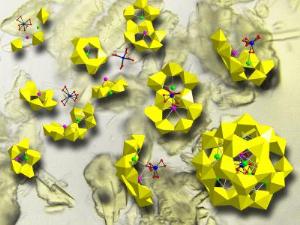 |
The diagrammatic image, viewed from upper left to bottom right, shows steps in the templated creation of radioactive compounds. In this case, the red spidery-looking shape is oxygen building a cage around tantalum (blue sphere) ; green sphere is potassium, pink is cesium. The yellow boxes are uranyl peroxide. Chemical attractions force the disparate parts to self-assemble. The background is a transmitted light-microscope image of crystals of the final product, U28.
[Credit: Sandia National Laboratories] |
The synthesized materials are stable, pure and can be studied in solution or as solids, making it easier to investigate their chemistry, transport properties and related phases.
The compounds are bright yellow, soluble peroxides of uranium called uranyl peroxide. These and related compounds may be present in any liquid medium used in the nuclear fuel cycle. They also appear in the environment from natural or human causes.
Made with relatively inexpensive and safe depleted uranium, the recipes may be adapted to include other, more radioactive metals such as neptunium, whose effects are even more important to study, Nyman said.
Cesium - an element of particular concern in its radioactive form - proved to be, chemically, an especially favored template for the compounds to self-assemble.
The work was done as part of the Actinide Materials Department of Energy (DOE) Energy Frontiers Research Center (EFRC) led by professor Peter Burns at Notre Dame University. Using the new method, researchers at the University of California-Davis are studying how materials behave in water and in different thermal environments, while researchers at DOE's Savannah River Site study the analogous behavior of neptunium.
The research will be featured as the cover article of the May 3 online European Journal of Inorganic Chemistry, to be published in print May 13, 2011 [see below]. It currently is highlighted in preview in the online ChemViews Magazine.
Sandia National Laboratories is a multiprogram laboratory operated and managed by Sandia Corporation, a wholly owned subsidiary of Lockheed Martin Corporation, for the U.S. Department of Energy's National Nuclear Security Administration. With main facilities in Albuquerque, N.M., and Livermore, Calif., Sandia has major R&D responsibilities in national security, energy and environmental technologies, and economic competitiveness.



